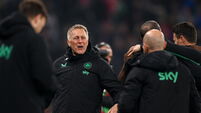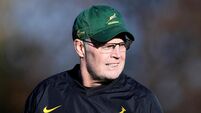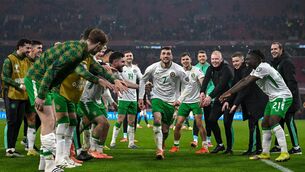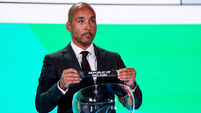John Riordan: How Cruyff and Best are still wowing crowds in a New York neighbourhood

The Cruyff and Best mural painted by BKFoxx at The Ground in the Two Bridges neighbourhood of Manhattan's Lower East Side. Image: John Riordan
Very early in Kenneth Branagh’s latest film, Belfast, there is a brutal disruption of the youthful innocence held dear by the main character, a nine-year-old Protestant boy whose ambition is to fight dragons or be the greatest footballer in the world.
His narrow working class street forms a T-shape with another row of terraced houses, forming a seemingly safe and enclosed haven in which a mixed community can live harmoniously together towards the end of the 1960s.
Painted onto the gable of one of the rows of houses are a pair of goalposts and a crossbar over which is emblazoned in simple, clear writing: “Danny Blanchflower N Ireland”.
The camera sweeps around the giddy young street footballers and across their simple mural which will survive the civil war destruction that’s about to shake this community and change it forever.
The Catholic families are chased out, the barricades go up and the humble little goalmouth becomes a steady, reliable background for a new, harsher reality.
Branagh used the earliest phase of lockdown more productively than most of us would dare dream possible by writing a script based on his coming-of-age in Belfast before his family was forced to move to England.
He somehow then found the time and energy to produce and direct a stellar cast for a film which comes out here next month before it receives a release early next year in Europe. The modern movie isn’t meant to turn around that quickly.
The promotional tour is in full swing and Branagh swept through New York on Tuesday with Focus Features, the distribution powerhouse, putting a lot of its marketing weight behind a production for which reviews have already been very enthusiastic.
I was fortunate to snag a ticket for the Midtown Manhattan screening and all day, I anticipated and wondered if a late 60s Belfast flick called Belfast and soundtracked by Van Morrison would go for the trifecta and feature a reference to the wonders of George Best.
Always an effective symbol of escapism, there’s a mural of Best in the Lower East Side of Manhattan which emerged out of the darkest days of 2020’s lockdown and has caused a stir around the hipster soccer circles so enamored by what they like to call Fútbol. The Spanish version has been used for years in order to avoid scorn from the UK and Ireland for use of the word ‘soccer’ while also distinguishing it from American Football.
The hyper realist rendering of the Manchester United icon, painted by an incredible New York muralist named BKFoxx, has him looking a little skyward. It’s a youthful Best, the one we all want to preserve in our memory, if we’re being honest with ourselves. To his right is Johan Cruyff, looking just as cool and just as young but staring straight at you. And then further along, to Cruyff’s right, is a recreation of World Cup 1986 Diego Maradona. He’s standing for the pre-final national anthem with the purest, deepest resolve in his eyes. The West Germans are beaten and the game hasn’t yet begun.
Just like Branagh’s Belfast, the nostalgia is depicted in black and white. The project was commissioned by the owners of The Ground, a soccer-inspired space with a bar and a couple of 4-aside pitches located in the shadow of the Manhattan Bridge in a neighborhood called Two Bridges.
Having been introduced to the owners by another local artist, the plan was for BKFoxx to adorn their new enterprise with what they describe as a Wall of Heroes and what she very accurately describes as a large rendition of a young adolescent football fan’s bedroom wall.
Facing that iconic trio are paintings of Franco Baresi, posing stoically in his turn of the 90s Milan jersey, and Sir Alex Ferguson, whose smiling visage takes pride of place right next to the facility’s front door.
As is mandatory with many young Americans, BKFoxx was forced into playing soccer at the age of six out on the Long Island suburb in which she grew up.
“It’s pretty standard in our culture - no one cares about soccer, but we do have to play soccer as a child. And after that, I couldn’t tell you too much about the sport. But let me tell you, I learned a lot!”
Nor does she have any formal artistic training.
“I just started graffitiing in abandoned buildings and people started to see what I was doing and asking me to do little jobs for them. Then it kind of went from there.”
The power of social media meant it was always inevitable that far-flung fans would begin to discover her artwork and also discover this tucked away corner of the city, a district which is difficult to find even with good access to a map.
“I cannot believe the level of response - sometimes it’s a little bit shocking,” BKFoxx told me by phone on Wednesday.
“When I was still painting the Maradona part, there were guys coming down on their bikes with Argentinian flags, taking photos and video.” That Maradona phase of the production was delayed by the peak of the lockdown. She abandoned a sketch outline of the player that must have been a haunting symbol of the sudden pause enforced on the city.
“There were eight weeks in between where nothing happened. I had finished Baresi and Alex Ferguson but the other side wasn’t done and then everything came to a screeching halt. It was March 13 and I remember driving home through Chinatown and it was like a zombie wasteland. I’d never seen anything like it before in my life, especially not in New York City.”
Six months after she completed the Maradona mural, he tragically passed away and The Ground became a shrine to which New York’s Argentinean community flocked in their droves. Camera shy BKFoxx was even coaxed into featuring in a short video interview conducted by the country’s Consular staff. She sent me a link but pointed out that she could never bring herself to watch it.
I did watch and, in spite of its low quality production values, it’s fascinating to watch the interviewers struggle to overcome their emotions as they try to explain to the artist what her Maradona mural means to them and their country.
“Maradona IS Argentina,” they say as their voices crack.
She has watched with pride from afar as social media spikes of interest popped up in Italy for the depiction of Il Capitano and in Northern Ireland for the rendering of Best. Her grandmother is from Newry, adding a layer of meaning to the reaction in Ulster.
It wasn’t all positive though. Some passersby wanted to know why Pele and Zidane didn’t make the cut. Such is the artist’s burden that you can’t please everyone all of the time.
I was guilty of the same thing. What I hadn’t known when I asked Kenneth Branagh why Blanchflower was chosen over Best was that the actor and director is a diehard, lifelong Spurs fan.
“I was born in the middle of the 1960-61 double season and Danny Blanchflower was the greatest player in the world in my eyes,” he told me at the film’s after party.
As with the owners of The Ground, Branagh’s ode to his childhood is his alone and we are invited to enjoy.
A week ago, the US government finally announced the exact date that EU citizens would be allowed to travel over here.
One of the subjects of last week’s column, Kevin McCarthy, was hopeful his brother would be able to travel over to support his running of the New York City Marathon but, alas, that dream was dashed by the arbitrary choice of Monday, November 8 as the chosen day for the lifting of the travel ban.
Once EU tourism begins to return to pre-pandemic levels, the ground will be a new stop for football fans who would never find themselves being drawn to that chaotic slice of life nestled between the Manhattan and Brooklyn Bridges. And if you find yourself down there for a day trip, don’t forget to look out for the 1990s Cork City jersey hanging just inside the front door.
@JohnWRiordan

Unlimited access. Half the price.
Try unlimited access from only €1.50 a week
Already a subscriber? Sign in








